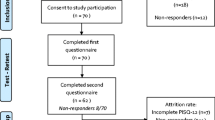Abstract
Introduction and hypothesis
We studied a web-based version of the Pelvic Organ Prolapse/Urinary Incontinence Sexual Function Questionnaire (PISQ-12).
Methods
A randomized crossover study in which subjects completed both a web-based and paper-based version of the PISQ-12, with a 2-week separation between the completion of the two versions. Demographic data and questionnaire preferences were also assessed. Group 1 completed the web version first, and group 2 completed the paper version first.
Results
We recruited 52 women and 50 (96.2%) completed the study. Demographic data were similar for the two groups. There was no difference in total PISQ-12 score (P = 0.41) and a high degree of correlation between versions (r = 0.88). Women preferred the web-based PISQ-12 (77.6%) over the paper-based version.
Conclusion
The web-based version of the PISQ-12 is a reliable alternative to the standard paper-based version and was preferred by women in this study regardless of age, race, and education.

Similar content being viewed by others
Abbreviations
- PISQ-12:
-
Pelvic Organ Prolapse/Urinary Incontinence Sexual Function Questionnaire 12
References
Nygaard I, Barber MD, Burgio KL, Kenton K, Meikle S, Schaffer J et al (2008) Prevalence of symptomatic pelvic floor disorders in US women. JAMA 300(11):1311–1316
Rogers RG, Villarreal A, Kammerer-Doak D, Qualls C (2001) Sexual function in women with and without urinary incontinence and/or pelvic organ prolapse. Int Urogynecol J Pelvic Floor Dysfunct 12(6):361–365
Rogers RG, Kammerer-Doak D, Villarreal A, Coates K, Qualls C (2001) A new instrument to measure sexual function in women with urinary incontinence or pelvic organ prolapse. Am J Obstet Gynecol 184(4):552–558
Rogers RG, Coates KW, Kammerer-Doak D, Khalsa S, Qualls C (2003) A short form of the Pelvic Organ Prolapse/Urinary Incontinence Sexual Questionnaire (PISQ-12). Int Urogynecol J Pelvic Floor Dysfunct 14(3):164–168, discussion 168
Newman JC, Des Jarlais DC, Turner CF, Gribble J, Cooley P, Paone D (2002) The differential effects of face-to-face and computer interview modes. Am J Public Health 92(2):294–297
Turner CF, Ku L, Rogers SM, Lindberg LD, Pleck JH, Sonenstein FL (1998) Adolescent sexual behavior, drug use, and violence: increased reporting with computer survey technology. Science 280(5365):867–873
Drummond HE, Ghosh S, Ferguson A, Brackenridge D, Tiplady B (1995) Electronic quality of life questionnaires: a comparison of pen-based electronic questionnaires with conventional paper in a gastrointestinal study. Qual Life Res 4(1):21–26
Ryan JM, Corry JR, Attewell R, Smithson MJ (2002) A comparison of an electronic version of the SF-36 General Health Questionnaire to the standard paper version. Qual Life Res 11(1):19–26
Geller EJ, Barbee ER, Wu JM, Loomis MJ, Visco AG (2007) Validation of telephone administration of two condition-specific quality-of-life questionnaires. Am J Obstet Gynecol 197(6):631–634
Kwon S, Visco AG, Fitzgerald MP, Ye W, Whitehead WE (2005) Validity and reliability of the Modified Manchester Health Questionnaire in assessing patients with fecal incontinence. Dis Colon Rectum 48(2):323–331, discussion 331–324
Hewett PC, Mensch BS, Ribeiro MC, Jones HE, Lippman SA, Montgomery MR et al (2008) Using sexually transmitted infection biomarkers to validate reporting of sexual behavior within a randomized, experimental evaluation of interviewing methods. Am J Epidemiol 168(2):202–211
Richter JG, Becker A, Koch T, Nixdorf M, Willers R, Monser R et al (2008) Self-assessments of patients via Tablet PC in routine patient care: comparison with standardised paper questionnaires. Ann Rheum Dis 67(12):1739–1741
Bliven BD, Kaufman SE, Spertus JA (2001) Electronic collection of health-related quality of life data: validity, time benefits, and patient preference. Qual Life Res 10(1):15–22
Handa VL, Barber MD, Young SB, Aronson MP, Morse A, Cundiff GW (2008) Paper versus web-based administration of the Pelvic Floor Distress Inventory 20 and Pelvic Floor Impact Questionnaire 7. Int Urogynecol J Pelvic Floor Dysfunct 19(10):1331–1335
Theiler R, Bischoff-Ferrari HA, Good M, Bellamy N (2004) Responsiveness of the electronic touch screen WOMAC 3.1 OA index in a short term clinical trial with rofecoxib. Osteoarthritis Cartilage 12(11):912–916
Whitcomb EL, Rortveit G, Brown JS, Creasman JM, Thom DH, Van Den Eeden SK et al (2009) Racial differences in pelvic organ prolapse. Obstet Gynecol 114(6):1271–1277
Acknowledgements
This project was supported by award number UL1RR025747 from the National Center for Research Resources.
Conflicts of interest
None.
Author information
Authors and Affiliations
Corresponding author
Additional information
The content is solely the responsibility of the authors and does not necessarily represent the official views of the National Center for Research Resources or the National Institutes of Health.
Rights and permissions
About this article
Cite this article
Parnell, B.A., Dunivan, G.C., Connolly, A. et al. Validation of web-based administration of the Pelvic Organ Prolapse/Urinary Incontinence Sexual Function Questionnaire (PISQ-12). Int Urogynecol J 22, 357–361 (2011). https://doi.org/10.1007/s00192-010-1297-8
Received:
Accepted:
Published:
Issue Date:
DOI: https://doi.org/10.1007/s00192-010-1297-8




